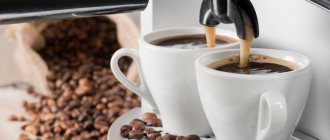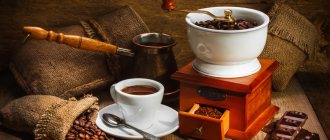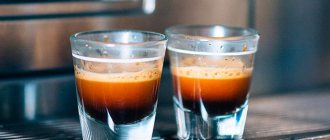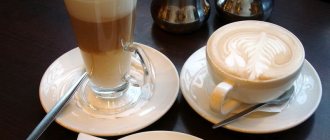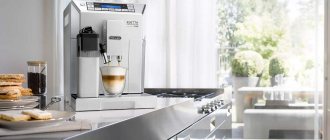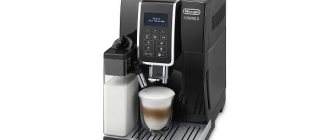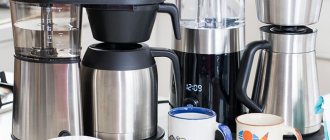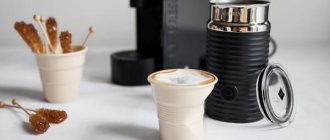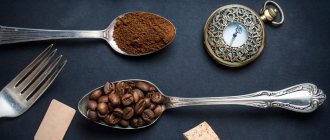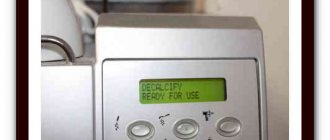Functions and components of a coffee machine
The task of the coffee machine is to grind the poured beans and pass hot water steam through them. The person presses a button and receives the finished drink ordered in accordance with the program. Models differ in their set of functions. They heat the glasses, whip the cream, grind the grains coarsely and finely.
To perform all the functions, the inventors equipped the coffee machine with:
- containers for water, coffee beans and waste products;
- dispensers;
- devices for grinding and brewing;
- tubes, pump (pump).
How all this interacts with each other is described in the article “Design and principle of operation of a coffee machine.”
What a simple coffee maker does is clear from the name. She's just brewing. The coffee is poured already ground. Boiling water is poured inside the device and a single flavor recipe is obtained. And no pressure affects him.
The bar determines the strength of the water
But coffee makers are constantly being improved. Models with a semi-automatic operating principle have appeared. Special mechanisms measure the required volume of powder and water and warm the cups before serving, just like in coffee machines.
Capsules and the drip brewing method already allow you to experiment with water pressure. In pressure coffee makers, boiling water is pressed through a layer of ground coffee.
The unit of measurement for water pressure was 1 bar. It does not belong to any measurement system, but people all over the world have recognized it. Physicists consider 1 atmosphere to be an equivalent parameter, but they try not to use it.
Did you know that the wrong pressure makes coffee worse?
Not really
History of coffee makers
Optimal indicator
The pressure level in a coffee machine and coffee maker affects the formation of foam, enrichment of aroma, creation of taste, and cooling of the drink.
A pressure gauge reading of 9 bar guarantees good espresso coffee. It serves as the basis for all other coffee recipes. But it took years of work by inventors to arrive at this figure.
The first Italian mechanics
An Italian inventor named Moriondo created a device with a water vapor pressure of 1.5 bar. Patented in 1885, the coffee maker existed for 7 years. Luigi Bezzera improved it and achieved an indicator of 2 bars. But it was not possible to keep it constant. Whatever grain he ground during the cooking process, the taste in each cup was different in strength.
Signor Pavoni came up with the idea of installing a control valve. This helped keep the pressure at the same level. But it was not possible to increase the steam force. The figure did not exceed 2 bar.
Interesting! How to prepare coffee beans correctly
Down with manual labor
The optimal pressure of 9 bar was achieved by 1940, when an additional lever was used to pump water. With this invention, Achil Gadzhia's establishment went down in history. The name appeared - coffee machine. The barista served the drinks with thin foam. It has become an indicator of proper espresso.
The manual piston was replaced with an automatic one after 20 years. Italian Carlo Valente used an electric pump. Now, creating the desired steam did not require any effort, and the taste of the coffee drink became better due to the precise brewing time.
Electronics got involved
The massive use of electronics at the end of the 20th century in all areas was also reflected in coffee machines. Inventors create multifunctional devices.
The desired button allows you to select the option of preparing a hot or cold drink. The menu depends on the device model.
Technical indicators of the coffee maker that affect the taste
The material of the horn body is of particular importance. If the part is made of steel, then when boiling water gets into it, the coffee tablet warms up well. Consequently, the grains release all the aromatic substances. In a plastic case, the drink turns out watery due to insufficient heating.
The boiler also creates pressure, only in this case steam for frothing milk. If the pressure in the coffee machine boiler rises, a safety valve opens and releases it. The temperature of the water in the coffee machine boiler depends on the amount of coolant inside.
In professional models it reaches 120 degrees. The container is usually filled to 70% so that excess pressure does not damage the assembly. The liquid in the boiler is not used to brew coffee - it serves as a heat source to heat the water that will be used to make espresso.
The amount of liquid in the boiler is an important indicator for the stable operation of the coffee maker. The larger it is, the better it holds the temperature and the better the brewing liquid heats up.
Dispensing tubes, of which there may be several depending on the performance of the unit, are the nodes through which boiling water flows to the holder. The more dispensing units, the more portions you can prepare at the same time. The pressure in these units corresponds to the required 9 bar.
Why is steam needed in a coffee machine - to supply it to an automatic cappuccino maker or a steam wand for manually frothing milk. The temperature of the steam in a coffee machine is usually the same as the temperature of water, so when using the wand you need to be careful not to direct the stream onto areas of the body.
Adjusting the pressure in the coffee machine
A sensor installed inside the unit prevents overheating of the unit if the equipment operates in continuous mode. When you turn on the machine, you can determine from its indicators that the unit is ready for operation.
In automatic models, the sensor can alert users to problems by displaying an error message. In manual and semi-automatic coffee makers, you need to independently monitor the sensor indicators.
There are 2 pressure gauges in the coffee machine - for the boiler and pump. After using steam to froth milk, the pressure in the boiler may drop below the permissible level. Monitoring the arrow readings, you need to wait until the machine restores functionality, that is, it heats the water to the desired temperature and the steam creates the required pressure.
The pump pressure gauge shows the pressure in the espresso brew group. In the operating mode of a good coffee maker it is 8 - 9 bar. When the equipment is disabled – 0.
About pressure in different types
Drip brewing
If we take into account the stages of development of coffee makers, then the operating principle of the drip variety remains at the level of the 19th century. The water boils in the boiler, drops of condensate flow through the brewing unit into the prepared cup.
Expert opinion
Vadim Kudryavtsev
Coffee expert, professional barista and simply in love with this aromatic drink.
Ask the barista a question
Brewing occurs not with boiling water, but with liquid cooled by condensation at a temperature of 90-92 degrees. This way, more natural nutrients are preserved. The unit maintains pressure at 1.5 bar.
Only Americano is prepared in drip devices. For cooking, use medium grind grains
Universal percolators
In percolators, steam from boiling water travels up a tube, onto the coffee powder, and then onto the filter. Previously, to circulate water, the vessel was heated with coal, now - with electric heating elements.
The finished drink flows into a container and is poured into cups. Pressure 1.5 bar, water temperature 100 degrees.
The percolator has one container for water and the finished drink. This means it is bitter due to constant brewing. The versatility of the device lies in the ability to make a regular kettle out of it. To do this, you need to remove the percolation system.
Moke - geyser installation for brewing coffee
In this device, the liquid is heated on a gas burner and boils at the bottom of the device. Boiled water (100 degrees) rises and immediately passes through the filter funnel with coffee. Steam pressure 1.3 - 1.5 bar.
The finished brewed product ends up at the top of the installation. It pours into cups through the spout.
Now let's talk about what the grind size affects. To prevent excess substances from getting into the finished product, it is important to use a medium grind or a little finer for this brewing method.
Options for espresso
To make espresso you need to buy a steam or pump coffee maker.
In steam water, it boils in 2 minutes, turns into steam and enters the horn filter under a pressure of 5 bar. The liquid temperature is 100 degrees, which is a minus. Boiling water “pulls out” the bitterness from the grains.
Expert opinion
Vadim Kudryavtsev
Coffee expert, professional barista and simply in love with this aromatic drink.
Ask the barista a question
The most accurate espresso is made by pump-action models, where the water does not boil, but only heats up to 90 degrees.
The pump applies a pressure of 7 bar to a compacted coffee tablet. Both types of coffee makers create milk foam when brewing cappuccino. There is a special steam pipe for this.
Coffee machines work similarly. The pressure is not raised to 15 bar, since the standard for espresso is 9 bar.
Carob varieties
Carob coffee machines include semi-automatic and automatic coffee machines. This is a common type of espresso coffee maker. The grains in the required quantity are placed in the horn, which is why the design got its name. Otherwise the horn is called a holder.
Interesting! How to brew ground coffee in a cup
In pump-action carob machines, the water reaches a temperature of a maximum of 95 degrees. Using a pump that creates a pressure of 8-10 bar, the liquid is pushed into the horn. In steam devices, the pressure ranges from 4 to 5 bar, and the water boils.
To preserve the taste and aroma of the drink, it is preferable to take a pump-action carob model.
The advantage of capsule types
If you don't want to bother with beans, buy a good capsule coffee machine. The name means that the unit operates on capsules. A person takes pressed coffee (capsule) and puts it in the desired compartment. One finger press and the process begins.
A hollow needle pierces a coffee capsule. Water (100 degrees) is supplied through the needle using a pump under a pressure of 5-15 bar. After passing through the coffee powder, the liquid is poured into the cup.
The drink options depend on what capsules we use. This could be tea or drinks with cream or milk.
Do you think the coffee from a regular coffee machine is different from a capsule coffee machine?
Not really
Combination devices
If you take a combination coffee maker for use, you can catch two birds with one stone. The main advantage is saving kitchen space. The disadvantages include a lot of effort to care for the nodes, because there are twice as many of them.
When combined, the drip design is combined with espresso. This unit makes a choice of espresso and Americano.
Another design combines a geyser with espresso. Two prescriptions are also issued upon request. The pressure in the machines ranges from 5 to 15 bar. Water temperature is from 90 to 100 degrees. The indicators depend on the selected type of coffee.
Both units are convenient when using capsules and tablets (pods). If desired, you can get a cappuccino.
Automation for ease
The development of modern technology and electronics has led to the creation of fully automated coffee machines. A person is required to load grains and water into containers. The only effort is pressing the desired button.
The devices have special panels with options for ready-made drinks. Among the possible types:
- milk lattes and cappuccinos;
- strong with less ristretto volume;
- voluminous due to lunge water;
- capsule hot chocolate.
Most of these recipes use espresso as a base. Only the proportions of milk, cream, water change and the formation of foam is controlled.
The creation of the recipes listed depends on the water vapor pressure in the coffee machine. The minimum indicator is 4 bars, the maximum is 20.
Electric Turks
Don’t forget about the simplest devices. This is a Turk - a dish in the form of a small jug with a spout for easy pouring of the finished drink. The Arabs call it cezwa. Traditionally, they are made of copper and placed on an open fire, after pouring water and adding ground coffee. This is an old, proven method in which coffee was prepared in the east.
An electric Turk can be considered the same simple coffee maker. A portion of coffee is also poured into it and water is poured in, which is brought to a boil, but using heating elements. We are not talking about pressure here. And the water heats up to 100 degrees.
Low pressure pods
Coffee makers that are used to prepare portions in ready-made bags are called pod coffee makers. The operating principle is similar to horn devices. In steam models, a pod filter is additionally used.
Hot water at a temperature of 100 degrees passes through a bag of ground coffee. The aroma is guaranteed, but foam does not form, since the water pressure is only 3-4 bar.
Interesting! How many grams of coffee are in a teaspoon and a tablespoon?
Who are carob coffee makers suitable for?
Before a more detailed description, I will bring to the beginning the main idea that the reader should understand:
A normal carob coffee maker is highly specialized in espresso and drinks based on it. That is why they are also called espresso coffee makers
That is, if you clearly understand that you prefer Turkish coffee (from a Turkish or electric Turkish coffee), from a geyser or, for example, filtered (as an option, “alternative” brewing), then in principle you do not need a carob coffee maker. Attempts to make something closer to the above from a “horn” usually resemble dental treatment through the nose.
On the other hand, for espresso and drinks based on it, a carob-type coffee maker is necessary and sufficient equipment. Here I leave coffee machines out of brackets, because grain machines and competent capsule machines actually try to bring the process closer to brewing in a classic carafe.
Conclusions and tips for choosing coffee equipment
For those who value time
Let's summarize how much bar should be in the coffee maker for normal operation. The figure depends on what we want to get as a result. For a classic espresso with foam, you need a technique that creates a pressure of 9 bar.
Carob pump, capsule with pump and combined devices are suitable. Under the Krups and Bosh Tassimo brands, manufacturers produce espresso coffee makers with a full cycle and automation. We recommend them to those who work a lot, are constantly busy and do not like to spend a lot of time in the kitchen.
For large volumes
In new generation coffee machines, pressure can reach from 3 to 20 bar. Such devices include multifunctional products from the Swiss company Cremesso, which work with a pump.
You can track the result on the pressure gauge. But no one is using full power. For quick cooking, 15 bar is enough. The water temperature reaches 92 degrees. A cup of coffee is prepared in 30 seconds.
This speed is needed when servicing a large number of clients, guests, and employees. The unit is suitable for offices, cafes and large families. Pay attention to the Jura and Melitta brands. If you are looking for a machine for your home, read the article “Coffee machine or coffee maker: which is better for the home.”
No rush in a small company
For simple brewing, a low pressure of 2-4 bar or a pressure-free device is sufficient. They are used by people who are not in a hurry, enjoy the process and do not expect many guests in the house.
Suitable options:
- percolators;
- carob steam coffee makers;
- pods with low pressure;
- drip and geyser devices;
- electric turks.
Famous, Tefal", "Moulinex", "Bialetti".
Which automatic coffee machine to choose for your home or office
Many manufacturers advertise their products by saying how good and durable they are. Therefore, in order not to make a mistake, before purchasing you need to read reviews about automatic coffee machines for your home or office and choose the best one.
The first and main requirement for any device is its reliability. No one wants to spend a lot of money on equipment designed to improve their life and drag it around to repair shops. This means that you need to consider products from time-tested manufacturers.
Today, the first places in the ranking of the best devices with a cappuccino maker for home and offices are automatic grain coffee machines from well-known brands: BOSCH, DELONGHI, MELITTA, NIVONA, PHILIPS and others.
How to adjust pressure
Signs of a fall
If a drink comes out of the machine without foam or aroma, and the taste resembles an ordinary “chatterbox”, it is worth checking the readings on the pressure gauge.
If the finished drink comes out in a weak stream or does not come out at all, this also indicates a drop in pressure in the coffee machines.
Possible reasons
The pressure gauge readings may drop due to pump failure. This is the main mechanism affecting blood pressure. It works stably for 1-2 years. Once the warranty expires, it becomes unreliable.
Stopping the flow of liquid from the unit indicates an air lock.
The filter may become clogged if low-quality grains or capsules are regularly used for cooking. Often coffee particles clog the micro-holes due to the grinding being too fine. Do not use over-roasted coffee beans.
Have you ever had problems with pressure in your coffee machine?
Not really
